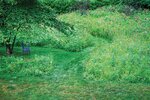

Americans have started to adopt alternative lawns, ditching the stereotypical plain patch of green for more vibrant foliage to profit themselves and their surrounding ecosystem.
“A fine lawn makes a frame for a dwelling,” said Abraham Levitt, in 1949. “It is the first thing a visitor sees. And first impressions are lasting ones.”
Levitt founded Levitt and Sons Inc., which built the Levittown neighborhoods in the late 1940s and 1950s in New York, New Jersey and here in Bucks County.
Somewhere along the way in establishing neighborhoods, a “perfect” lawn became part of the image the symbolized the American Dream: a house with a white picket fence and green grass.
Maintaining a “perfect lawn” is tedious, demanding and costly work, involving chemical fertilizers, weed killers, weekly mowing or weekly lawn care contracts that can exceed $100.
John Celentano, Yardley resident and amateur wildlife photographer, is part of the growing crowd of Bucks County residents to adopt alternative lawns that are less maintenance, that provide a home to pollinators and birds, increase biodiversity and reduce water contamination.
“We love nature and for years we’ve been trying to minimize the chemicals used on our property,” Celentano said. “This takes that to the next level, and not only minimizes the chemicals but finds something that helps the soil, birds and bees, and it’s beautiful,” he said referring to his wildflower front lawn.
Celentano and his wife Jane created a buzz in the borough with their new front lawn over the summer after switching from grass to native wildflowers promoting a splash of color and beauty. With the intense heat and rainfall that occurred, thousands of flowers flourished, some reaching heights of nine feet.
“We’re really happy to see it give other people joy,” Celentano said. “People send a letter or give a call to let us know how they’re starting their own. It was nice hearing it inspired others to have alternative lawns that are definitely friendly to the environment.”
The blossoms were not only enjoyed by community members walking and driving by but also by an abundance of pollinators and birds.
Some pesticides, when sprayed onto plants kill clovers and dandelions, which serve as a resource for pollinators. They can also create potential for poisoning beneficial insects and birds, alternative lawn advocates argue.
Turf grass’ shallow roots and lawns’ compacted soil can limit water absorption when it rains. That increased runoff can pick up more pollutants from yards and streets transferring them into nearby streams that cause toxic algal blooms that can hurt aquatic life and people.
Meadows and woods, on the other hand, can help prevent flooding with their deep root systems that are better at absorbing stormwater.
Maintenance for alternative lawns is very minimal, added Adam Cressman, founder of Pleasant Valley Farm and Garden LLC. Cressman assisted the Celentanos with their alternative lawn.
“Unlike mowing your lawn once a week this gets cut once a year,” he said.
Advocates say alternative lawns reduce homeowners’ contribution to air pollution.
According to the U.S. Environmental Protection Agency, one hour’s use of a new gasoline mower emits the same amount of volatile organic compounds and nitrogen oxide as driving a new car for 45 miles.
Cressman’s native wildflower mix is a mixture of annuals, which are plants with a one-year life cycle that will drop their seeds and come back next year, and perennials, which have a root system that stays there so they come back every year.
To plant the flowers, Cressman uses the practice of seed drilling.
“If you just sprinkle the seeds they don’t have as a good chance of germinating,” he explains. “It’s pretty simple, and it can be done on a very large or small scale, it can be acres or a small patch.”
“The first step is to accept nature is messy and to find beauty in the messiness,” Celentano said. “Make an environment that’s beautiful.”
For more information about alternative lawns, visit https://pleasantvalleyfarmandgarden.com/.
Join our readers whose generous donations are making it possible for you to read our news coverage. Help keep local journalism alive and our community strong. Donate today.